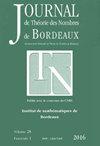Generalization of a density theorem of Khinchin and diophantine approximation
IF 0.3
4区 数学
Q4 MATHEMATICS
引用次数: 2
Abstract
The continuous version of a famous result of Khinchin says that a half-infinite torus line in the unit square [0,1] 2 exhibits superdensity, a best form of time-quantitative density, if and only if the slope of the geodesic is a badly approximable number. We extend this result of Khinchin to the case when the unit torus [0,1] 2 is replaced by a finite polysquare translation surface, or square tiled surface. In particular, we show that it is possible to study this very number-theoretic problem by restricting to traditional tools in number theory, using only continued fractions and the famous 3-distance theorem in diophantine approximation combined with an iterative process.Khinchin密度定理与丢番图近似的推广
Khinchin的一个著名结果的连续版本表明,单位平方[0,1]2中的半无限环面线表现出超密度,这是时间定量密度的最佳形式,当且仅当测地线的斜率是一个非常近似的数字。我们将Khinchin的这一结果推广到单元环面[0,1]2被有限多方平动面或正方形平铺面所取代的情况。特别是,我们证明了通过限制传统数论工具,仅使用连分式和著名的丢番图近似中的3-距离定理结合迭代过程来研究这个非常数论的问题是可能的。
本文章由计算机程序翻译,如有差异,请以英文原文为准。
求助全文
约1分钟内获得全文
求助全文
来源期刊

Journal De Theorie Des Nombres De Bordeaux
MATHEMATICS-
CiteScore
0.60
自引率
0.00%
发文量
35
期刊介绍:
The Journal de Théorie des Nombres de Bordeaux publishes original papers on number theory and related topics (not published elsewhere).
 求助内容:
求助内容: 应助结果提醒方式:
应助结果提醒方式:


